
birds of colorado field guide
Colorado’s diverse landscapes host over 500 bird species, from alpine to desert habitats, making it a vibrant destination for birders. Field guides like Stan Tekiela’s Birds of Colorado provide essential tools for identifying and understanding the state’s rich avifauna, organized by color for ease of use.
1.1 Overview of Bird Species in Colorado
Colorado is home to over 500 species of birds, ranging from migratory visitors to year-round residents. The state’s diverse landscapes, including mountains, plains, and wetlands, create a variety of habitats that attract a wide array of avifauna. From the iconic Lark Bunting, Colorado’s state bird, to the rare Mountain Plover, the diversity of species is remarkable. Waterfowl, songbirds, and raptors are well-represented, with many species adapting to both urban and natural environments. This richness makes Colorado a hotspot for birders, with field guides like Stan Tekiela’s Birds of Colorado Field Guide providing invaluable insights into identification and behavior, helping enthusiasts explore and appreciate the state’s vibrant bird life.
1.2 Importance of Field Guides for Bird Identification
Field guides are indispensable tools for bird identification, offering detailed descriptions, high-quality images, and insights into behavior and habitats. They enable birders to quickly recognize species, even for beginners, by organizing birds by color or family. Guides like Stan Tekiela’s Birds of Colorado Field Guide simplify identification with user-friendly layouts and regional specificity, focusing on species found in Colorado. They also highlight distinguishing field marks, songs, and seasonal variations, making birding more accessible and enjoyable. By providing reliable information, field guides empower enthusiasts to accurately identify birds, fostering a deeper appreciation for Colorado’s avifauna and enhancing overall birding experiences.

Choosing the Right Field Guide for Colorado Birds
Choosing the right field guide for Colorado birds involves selecting one with portability, color-organized entries, and user-friendly design. Stan Tekiela’s and National Geographic’s guides are recommended, offering detailed local species insights and expert tips for quick, accurate identification.
2.1 Key Features of a Good Field Guide
A good field guide for Colorado birds should be portable, with detailed, high-quality images and descriptions. It should include color-organized entries for easy navigation, as seen in Stan Tekiela’s guide. Features like quick-reference sections, expert tips, and habitat information are essential. The guide should cover local species and seasonal variations, ensuring relevance to Colorado’s diverse avifauna. Clear, concise text and intuitive organization, such as grouping by color or family, enhance usability; Additional tools like bird call descriptions or digital companions can further aid identification. These features collectively make a field guide indispensable for both novice and experienced birders in Colorado.
2.2 Recommended Field Guides for Colorado Birders
For Colorado birders, top recommendations include Birds of Colorado Field Guide by Stan Tekiela, known for its color-organized entries and portability. The National Geographic Field Guide to Birds offers comprehensive coverage, including bird calls. Another excellent choice is Kenn Kaufman’s Field Guide to Birds of North America, praised for its detailed illustrations and range maps. These guides are highly regarded for their accuracy, ease of use, and relevance to Colorado’s diverse avifauna. They cater to both beginners and experienced birders, providing essential tools for identifying and understanding the state’s bird species effectively.

Bird Identification Tips
Bird identification in Colorado is made easier by focusing on visual field marks, plumage patterns, and bird songs. Observing beak shapes and sizes helps distinguish species effectively.
3.1 Visual Field Marks and Plumage
Visual field marks and plumage are crucial for identifying Colorado’s birds. Distinctive features like stripes, color patterns, and feather shapes help distinguish species. For instance, the Mountain Bluebird is recognized by its vibrant blue plumage, while the Spotted Towhee displays distinctive black spots. Seasonal changes in plumage, such as the American Goldfinch’s shift from bright yellow to olive, are also key identifiers. Using field guides like Stan Tekiela’s Birds of Colorado, which organizes species by color, simplifies the identification process. Observing these visual cues ensures accurate and efficient bird identification in the field.
3.2 Bird Songs and Calls for Identification
Bird songs and calls are vital for identifying species, especially in Colorado’s diverse habitats. Many birds, like the Western Meadowlark, have distinctive melodies that aid recognition. The Northern Flicker’s call, often described as a loud, piercing “wicka-wicka,” is another example. Field guides, such as Stan Tekiela’s Birds of Colorado, often include descriptions of these vocalizations. Apps like Merlin Bird ID also offer audio samples, enhancing identification accuracy. By combining visual cues with auditory signals, birders can more confidently recognize species, even in dense vegetation or during breeding seasons when songs are prominent. This dual approach simplifies and enriches the birding experience in Colorado’s rich avifaunal landscape.
3.3 Behavior and Habitat Clues
Behavior and habitat clues are essential for identifying Colorado’s birds. For instance, waterfowl like herons and kingfishers are typically found near water, while meadowlarks inhabit open grasslands. Birds of prey, such as hawks and eagles, often soar overhead or perch in tall trees. Urban areas attract species like sparrows and pigeons. Observing feeding behaviors, flight patterns, and nesting habits can also help identify species. Field guides like Stan Tekiela’s Birds of Colorado highlight these clues, making identification easier. By noting a bird’s environment and actions, enthusiasts can narrow down possibilities, especially when visual markings are unclear. This approach enhances the accuracy of bird identification in Colorado’s diverse ecosystems.
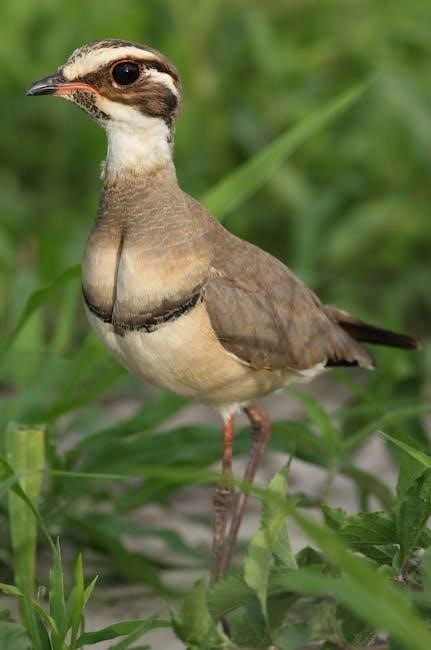
Common Bird Families in Colorado
Colorado is home to diverse bird families, including waterfowl, shorebirds, songbirds, and birds of prey. Each family thrives in unique habitats, showcasing the state’s rich avifauna diversity.
4.1 Waterfowl and Shorebirds
Waterfowl and shorebirds are abundant in Colorado, with species like ducks, geese, herons, and sandpipers thriving in wetlands and along waterways. These birds are highly migratory, often traveling long distances to reach Colorado’s lakes, rivers, and marshes. Shorebirds, such as plovers and sandpipers, are particularly notable during spring and fall migrations. Field guides like Stan Tekiela’s Birds of Colorado highlight key identification features, such as plumage patterns and bill shapes, which are crucial for distinguishing between similar species. Understanding their habitats and behaviors, like feeding in shallow waters or flocking during migration, enhances the birding experience in Colorado’s diverse wetland ecosystems.
4.2 Songbirds and Sparrows
Songbirds and sparrows are among the most diverse and abundant birds in Colorado, with species like the American Robin, Song Sparrow, and Yellow Warbler adding vibrancy to the state’s landscapes. These birds are known for their melodious songs, which play a crucial role in mating and territory defense. Field guides like Stan Tekiela’s Birds of Colorado often highlight their distinctive plumage patterns, bill shapes, and behaviors, making identification easier. Many songbirds are migratory, while sparrows tend to be year-round residents. Their adaptability to various habitats, from backyards to forests, makes them a delight for birders of all levels, showcasing Colorado’s rich avifauna diversity.
4.3 Birds of Prey and Owls
Colorado is a haven for birds of prey and owls, with species like hawks, eagles, falcons, and owls thriving in its diverse landscapes. These birds are apex predators, playing a vital role in maintaining ecosystem balance. Field guides such as Stan Tekiela’s Birds of Colorado highlight their distinctive features, like sharp talons and piercing gazes, aiding enthusiasts in identification. Owls, with their nocturnal habits, are often sought after by birders for their elusive nature. Birds of prey are known for their soaring abilities and keen vision, making them a thrilling sight in Colorado’s skies. Their presence underscores the state’s rich avifauna and attracts dedicated birders year-round.
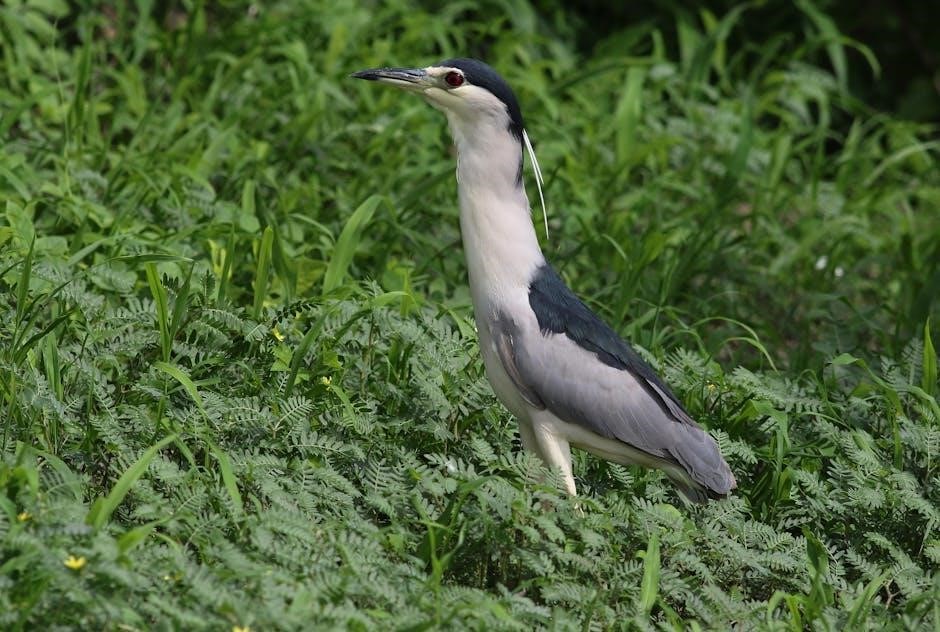
Habitat-Specific Birds in Colorado
Colorado’s varied landscapes, from mountains to plains, support diverse bird species adapted to specific habitats. Field guides like Stan Tekiela’s help identify birds unique to each ecosystem, enhancing birding experiences.
5.1 Birds of the Rocky Mountains
The Rocky Mountains in Colorado are home to a unique array of bird species adapted to high-altitude environments. Birds like the White-tailed Ptarmigan and the Clark’s Nutcracker thrive in these rugged landscapes. The alpine meadows and coniferous forests provide habitat for species such as the Broad-tailed Hummingbird and the American Dipper. Field guides like Stan Tekiela’s Birds of Colorado highlight the distinctive plumage and behaviors of these montane birds, aiding enthusiasts in identification. The Rockies also attract migratory birds during summer, offering a rich birding experience. Visitors can explore trails and meadows to spot these adaptations, making the Rockies a must-visit for birders seeking to witness Colorado’s alpine avifauna.
5.2 Birds of the Great Plains
The Great Plains of Colorado are characterized by vast grasslands and open spaces, hosting a variety of bird species adapted to these expansive habitats. Birds such as the Greater Prairie-Chicken, Burrowing Owl, and Lark Bunting are commonly found in this region. Field guides like Stan Tekiela’s Birds of Colorado emphasize the unique field marks and behaviors of these species, aiding in identification. The Great Plains also serve as critical stopover points for migratory birds, offering rich opportunities for birders to observe both resident and passing species. The open landscapes make it easier to spot birds like the Western Meadowlark and the American Kestrel, enhancing the birding experience in this iconic Colorado habitat.
5.3 Birds of Wetlands and Rivers
Colorado’s wetlands and rivers support a diverse array of birdlife, including waterfowl, shorebirds, and wading birds. Species like the American Avocet, Wilson’s Phalarope, and Great Blue Heron thrive in these habitats. Field guides such as Stan Tekiela’s Birds of Colorado highlight the unique plumage and behaviors of these birds, making identification easier. Wetlands are particularly important for migratory birds, providing crucial stopover points. The presence of rivers like the Colorado and South Platte creates habitats for kingfishers, dippers, and Belted Kingfishers. These areas are also nesting grounds for species like the Mallard and Cinnamon Teal. The combination of still water and flowing rivers ensures a rich variety of birdlife, making Colorado’s wetlands and rivers a birdwatcher’s paradise.
5.4 Birds of Urban Areas
Colorado’s urban areas, such as Denver and Boulder, are home to a variety of bird species that thrive in human-modified environments. Birds like the American Robin, Mourning Dove, and House Sparrow are common in city parks and backyards. Field guides such as Stan Tekiela’s Birds of Colorado often highlight these species, noting their adaptability to urban life. Urban birding offers unique opportunities to observe birds like the Black-capped Chickadee and Downy Woodpecker, which frequent backyard feeders. Additionally, cities often host migratory birds during spring and fall, making urban areas dynamic birding destinations. The presence of green spaces and water features further enhances biodiversity, attracting species like the Great Blue Heron and Belted Kingfisher to urban wetlands.
Seasonal Variations in Bird Populations
Colorado experiences dynamic bird population shifts across seasons, with spring and fall migrations bringing diverse species, while summer and winter host breeding and resident birds respectively.
6.1 Spring Migration
During spring migration in Colorado, birders witness an influx of diverse species as they travel through the state’s varied habitats. This period, typically from late March to early June, sees the return of warblers, tanagers, and orioles to woodlands, while waterfowl and shorebirds populate wetlands. The Rocky Mountains attract high-altitude breeders like the White-tailed Ptarmigan, and the Great Plains host species such as the Mountain Plover. Field guides like Stan Tekiela’s Birds of Colorado are invaluable for identifying these birds, as they often appear in breeding plumage, making color and visual field marks crucial for accurate identification. This season offers prime opportunities for spotting rare and migratory birds, enriching the experience for both novice and experienced birders.
6.2 Summer Breeding Season
Colorado’s summer breeding season is a peak time for bird activity, with many species establishing territories and raising young. The state’s diverse habitats support a wide range of breeding birds, from the Broad-tailed Hummingbird in mountain meadows to the Dickcissel in prairie regions. Field guides like Stan Tekiela’s Birds of Colorado are essential for identifying species based on breeding plumage and behavior. Bird songs play a crucial role during this season, as males establish territories and attract mates. Nesting sites vary, with some birds, like the American Dipper, nesting near streams, while others, such as the Western Tanager, breed in coniferous forests. This period offers excellent opportunities to observe unique courtship displays and fledglings learning to fly.
6.3 Fall Migration
Colorado’s fall migration brings a fascinating spectacle as birds move southward, with peak activity from August to October. Species like the Broad-tailed Hummingbird and Wilson’s Warbler traverse the state, utilizing habitats such as riparian corridors and mountain meadows; This period offers sightings of rare and migratory birds, including the Mountain Plover, which draws enthusiasts to festivals. Field guides, such as Stan Tekiela’s Birds of Colorado, are invaluable for identifying migrants based on plumage and behavior. Birders can observe unique flocking behaviors and stopover patterns, highlighting the importance of Colorado as a critical migration corridor. This season is a prime time for documenting diverse avifauna.
6.4 Winter Residents
Colorado’s winter birding scene is marked by hardy species that brave the cold, such as the Northern Cardinal, Black-capped Chickadee, and House Finch. These birds adapt to snowy conditions, relying on seed-filled feeders and evergreen shelters. Field guides like Stan Tekiela’s Birds of Colorado help identify these winter residents, showcasing their distinct plumage and behaviors. The state’s urban and natural habitats support a variety of year-round birds, making winter a unique season for observation. Birders can enjoy spotting these resilient species, often in backyard settings or open woodlands, highlighting Colorado’s diverse avifauna even in colder months. This period offers a quieter yet rewarding birding experience.
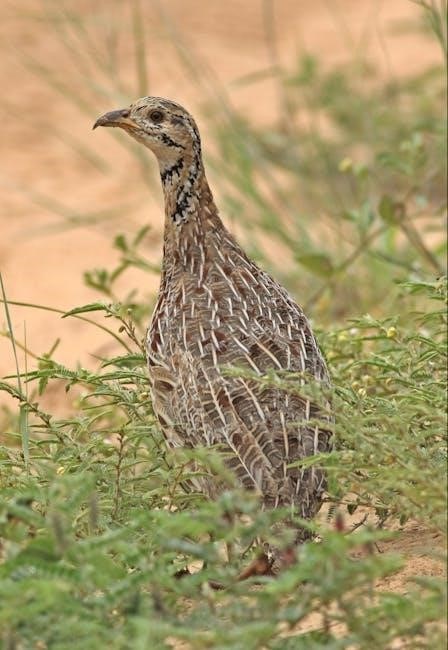
Birding Hotspots in Colorado
Rocky Mountain National Park and Chico Basin are renowned birding hotspots, offering diverse species and habitats for enthusiasts to explore with field guides like Stan Tekiela’s.
7.1 National Parks and Wildlife Refuges
Colorado’s national parks and wildlife refuges are prime destinations for birders. Rocky Mountain National Park offers alpine species like the White-tailed Ptarmigan, while Chico Basin Ranch attracts raptors and grassland birds. Barr Lake State Park is a hotspot for waterfowl and shorebirds, with over 300 species documented. Field guides like Stan Tekiela’s Birds of Colorado are invaluable for identifying these birds. These protected areas provide critical habitats, making them essential for both migratory and resident species. Birders can explore diverse ecosystems, from wetlands to mountain meadows, ensuring a rich and varied birding experience across Colorado’s national parks and wildlife refuges.
7.2 State Parks and Recreation Areas
Colorado’s state parks and recreation areas offer exceptional birding opportunities. Chatfield State Park is renowned for its waterfowl and raptors, while Eleven Mile State Park attracts a variety of waterfowl and ospreys. Highline Lake State Park is a hotspot for migratory songbirds and shorebirds. These areas provide diverse habitats, from wetlands to forests, supporting over 300 bird species. Field guides like Stan Tekiela’s Birds of Colorado are essential for identifying species. Portable and user-friendly, these guides help birders make the most of their visits to Colorado’s state parks, ensuring a fulfilling and educational birding experience amidst the state’s natural beauty.
7.3 Local Birding Trails
Colorado boasts an extensive network of local birding trails, offering birders a structured way to explore diverse avifauna. Trails like the Colorado Birding Trail and the Rocky Mountain Birding Trail cover vast regions, from the Rocky Mountains to the Great Plains. These trails provide detailed maps and guides, highlighting key birding hotspots. Field guides such as Stan Tekiela’s Birds of Colorado complement trail experiences by aiding in quick identification of species. Birders can spot everything from migratory songbirds to raptors, enhancing their appreciation of Colorado’s natural landscapes. These trails are perfect for both novice and experienced birders, fostering a deeper connection with the state’s birdlife.
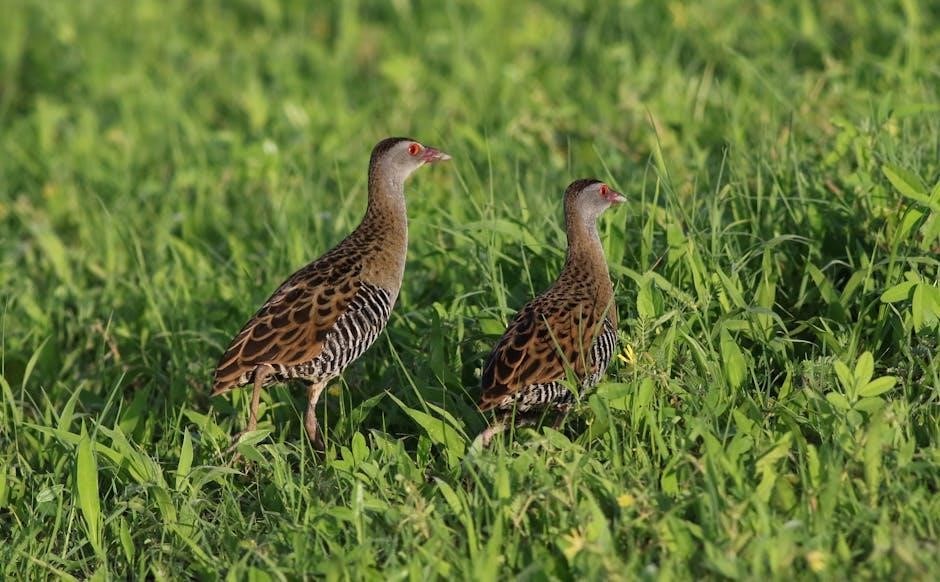
Birding Events and Festivals in Colorado
Colorado hosts annual birding events like the Mountain Plover Festival in Karval and birdwatching gatherings in Hasty, offering rare bird sightings and guided tours for enthusiasts.
8.1 Annual Bird Festivals
Colorado hosts a variety of annual bird festivals that attract enthusiasts from across the country. One of the most notable is the Mountain Plover Festival in Karval, which celebrates the rare Mountain Plover. This event draws birdwatchers eager to spot this elusive species. Similarly, the festival in Hasty offers unique opportunities to observe migratory and resident birds. These events often feature guided tours, expert lectures, and interactive activities, making them family-friendly and educational. Many festivals also emphasize conservation efforts, raising awareness about habitat preservation and the importance of protecting Colorado’s avifauna. Whether you’re a seasoned birder or a casual observer, these festivals provide unforgettable experiences and deeper connections to nature.
8.2 Guided Bird Tours
Guided bird tours in Colorado offer unparalleled opportunities to explore the state’s diverse avifauna with expert guides; These tours, often led by local birding enthusiasts, provide insights into habitats, behaviors, and identification techniques. Many tours operate year-round, catering to both beginners and experienced birders. Popular destinations include the Rocky Mountains, Great Plains, and wetland areas, where rare species like the Mountain Plover can be spotted. Guides equipped with extensive knowledge and field guides like Stan Tekiela’s Birds of Colorado ensure a enriching experience, helping participants identify and learn about the birds they encounter. Whether you’re exploring urban parks or remote natural areas, guided tours enhance your birding adventure and foster a deeper appreciation for Colorado’s birdlife.
8.3 Community Birding Events
Community birding events in Colorado foster camaraderie among bird enthusiasts while promoting conservation and education. Festivals like the Mountain Plover Festival attract birders from across the region, offering a chance to spot rare species. Local events, such as bird counts and habitat restoration projects, engage participants in hands-on activities. These gatherings often feature expert talks, workshops, and guided walks, providing opportunities to learn from experienced birders. Many events are family-friendly, encouraging the next generation of birders to develop a passion for nature. By participating in these events, individuals not only gain knowledge but also contribute to the protection of Colorado’s avifauna, making them a vital part of the birding community.

The Role of Birding in Conservation
Birding plays a crucial role in conservation by promoting awareness and supporting citizen science projects, which help protect Colorado’s avifauna and their habitats.
9.1 Citizen Science Projects
Citizen science projects are vital for bird conservation in Colorado, engaging enthusiasts in data collection and research. These initiatives, such as bird counts and breeding surveys, provide valuable insights into avifauna trends and habitat needs. By participating, birders contribute to large-scale studies that inform conservation policies and protect species. Field guides, like Stan Tekiela’s Birds of Colorado, often highlight how citizen science efforts aid in tracking populations and migration patterns.
Programs like the Christmas Bird Count and Colorado Breeding Bird Survey rely on volunteer observations, fostering community involvement and scientific collaboration. Such efforts not only advance ornithological knowledge but also promote public awareness of bird conservation needs.
9.2 Bird-Friendly Habitat Creation
Creating bird-friendly habitats is crucial for supporting Colorado’s avifauna and promoting biodiversity. Planting native vegetation, such as shrubs and flowers, provides essential food and shelter for birds. Installing water sources, like birdbaths or ponds, attracts a variety of species, while maintaining nesting sites preserves breeding grounds. Field guides often emphasize the importance of these habitats, offering tips for gardeners and landowners to create bird-friendly environments. By fostering these spaces, individuals contribute to the conservation of Colorado’s bird populations, ensuring their survival and diversity for future generations.
9.3 Raising Awareness for Bird Conservation
Raising awareness for bird conservation is vital for protecting Colorado’s avifauna. Educational programs, bird festivals, and guided tours engage communities, fostering appreciation for local bird species. Field guides like Stan Tekiela’s Birds of Colorado play a key role by providing accessible information on identification and habitat needs. These resources empower individuals to recognize the importance of conservation efforts. By participating in events like the Mountain Plover Festival, birders and enthusiasts alike contribute to the broader understanding of avian diversity and the need to protect it. Awareness campaigns highlight the impact of human activities on bird populations, encouraging sustainable practices and habitat preservation.
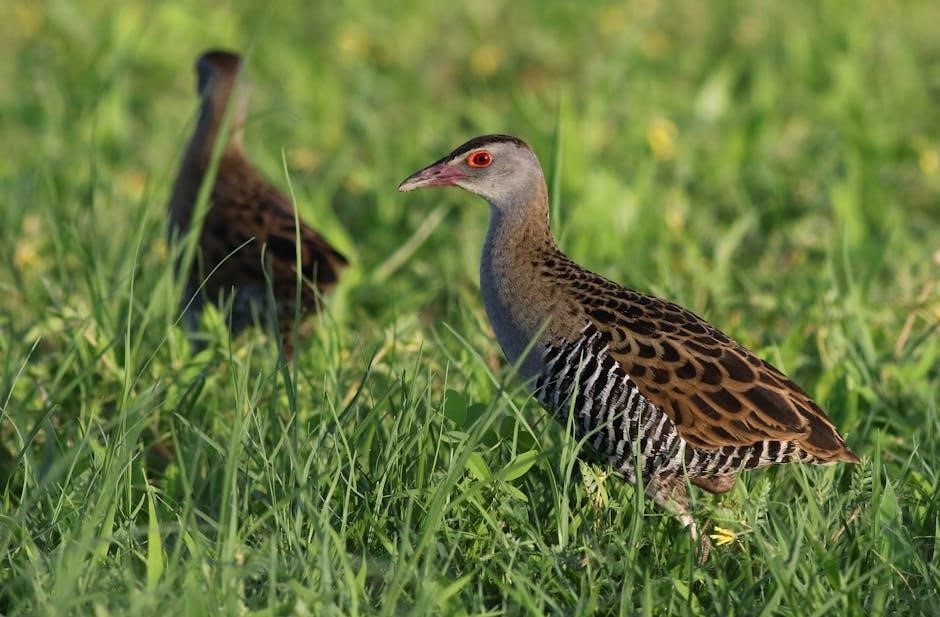
Additional Resources for Colorado Birders
Birding apps like Merlin Bird ID and local clubs such as Aiken Audubon Society offer valuable tools and community support for Colorado bird enthusiasts.
10.1 Birding Apps and Digital Tools
Birding apps like Merlin Bird ID and Audubon Birds of the Rockies offer Colorado birders innovative ways to identify species. Merlin Bird ID uses AI to identify birds from photos or descriptions, while Audubon provides detailed info, calls, and range maps. These tools are ideal for quick field identification and learning about bird behavior, habitats, and migration patterns. They also include features like birding lists and location tracking, helping enthusiasts keep records of their sightings. Digital tools complement field guides, making birding more accessible and engaging for both beginners and experienced birders in Colorado.
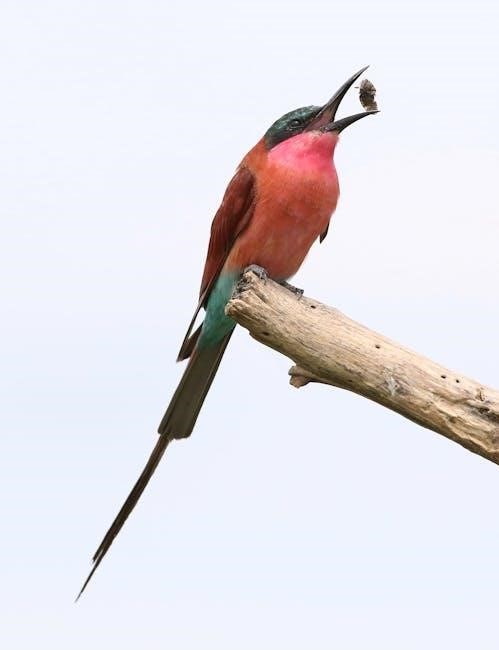
10.2 Local Birding Clubs and Societies
Local birding clubs and societies in Colorado play a vital role in fostering birding communities and promoting conservation efforts. Groups like the Aiken Audubon Society and the Colorado Ornithological Society organize regular birding trips, workshops, and meetings. These organizations provide platforms for birders to share knowledge, learn from experts, and participate in citizen science projects. Many clubs also collaborate with local wildlife refuges and parks to support habitat restoration and bird conservation. Joining these societies offers networking opportunities, access to exclusive events, and a deeper connection to Colorado’s avifauna. They are invaluable resources for both novice and experienced birders seeking to enhance their birding experience and contribute to bird conservation efforts in the state.
10.3 Online Forums and Communities
Online forums and communities are indispensable resources for Colorado birders, offering spaces to share sightings, ask questions, and learn from enthusiasts. Platforms like birding forums and social media groups dedicated to Colorado avifauna provide real-time updates on rare bird sightings and seasonal migrations. These communities often feature discussions on field guides, such as Stan Tekiela’s Birds of Colorado, and birding apps like Merlin Bird ID. They also serve as hubs for organizing virtual events and collaborative projects, fostering a sense of camaraderie among birders. Engaging with these online spaces enhances one’s birding knowledge and connects individuals across the state, creating a vibrant and inclusive birding network.

o positive blood type diet pdf
You May Also Like

singer manual sewing machine
August 18, 2025
24 hours a day reading for today pdf free download
July 5, 2025
